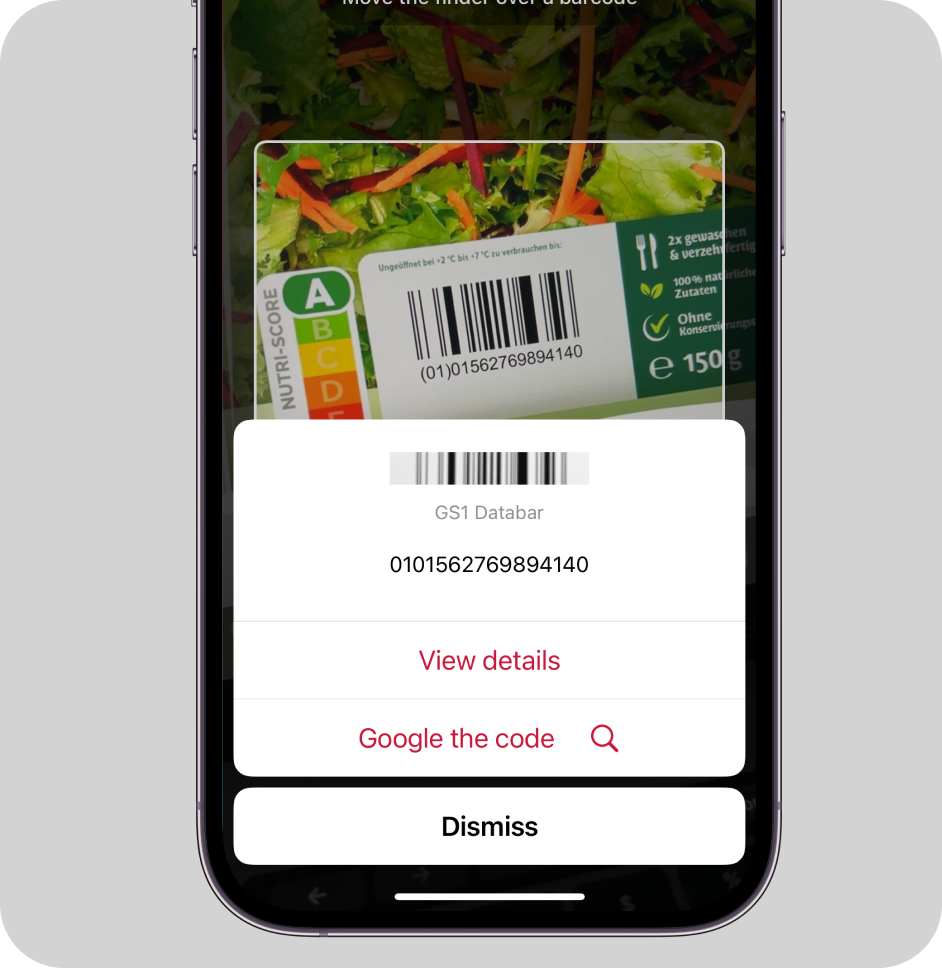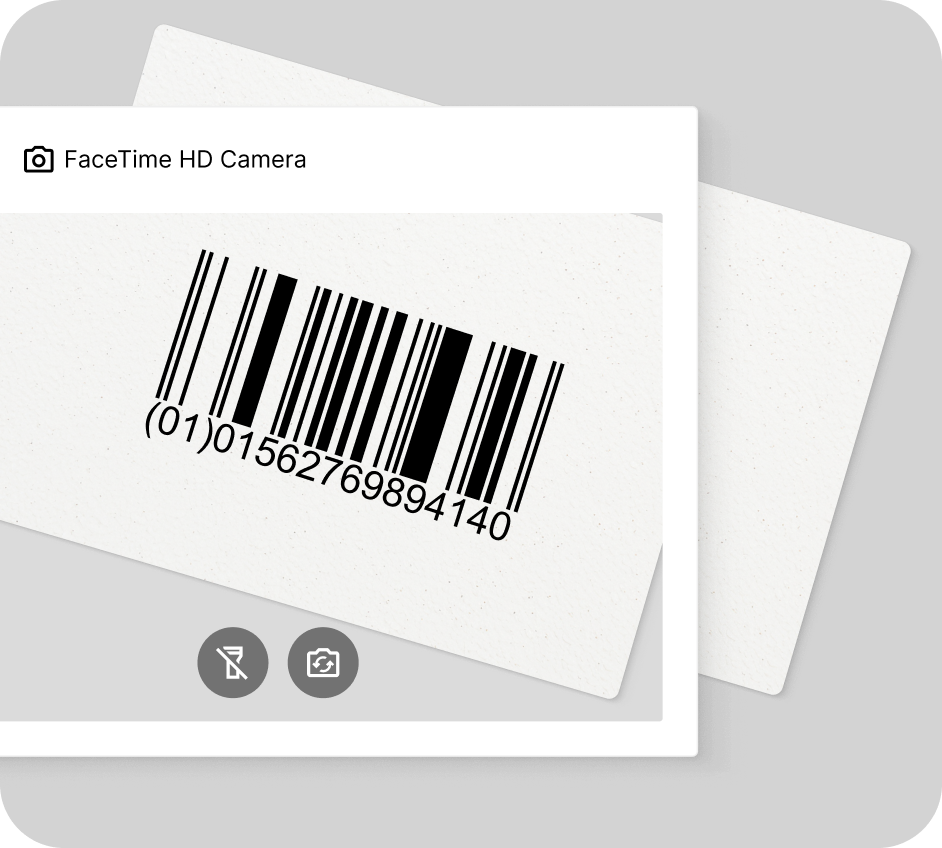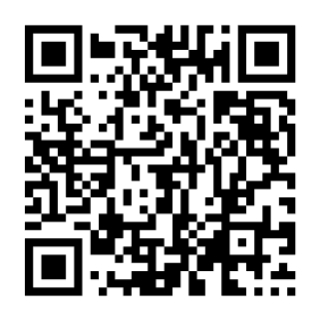GS1 DataBar Scanner
Add GS1 DataBar scanning to your mobile application or website
Trusted by
400+
global
industry leaders
Turn smartphones into fast & reliable GS1 DataBar scanners
The Scanbot GS1 DataBar Scanner SDK delivers exceptional performance even under challenging conditions – such as damaged barcodes or when reading compact barcodes found in retail and healthcare. With a scanning speed of under 0.04 seconds, your users get instant reads for seamless workflows.
Key benefits include:
- Offline scanning: The Scanbot SDK works 100% on-device, ensuring both uninterrupted performance and data security.
- Enterprise support: Questions or requests? Contact our technical support team. We’re happy to assist you.
- Flat pricing model: Cost stays the same no matter how much your user base or scanning volume grows.


How this scanning tool works
Our free online GS1 DataBar barcode scanner reads barcodes directly through your camera or on imported images. This scanner works in any browser, no app download or signup needed. Enjoy real-time camera view scanning or decode barcodes on pictures in seconds – just point your camera at the GS1 DataBar code or import an image file to instantly access the encoded data.
This tool is powered by the Scanbot Barcode Scanner SDK!
(We don’t store any images or data you import. Everything stays on your device.)
Understanding GS1 DataBar codes
What is a GS1 DataBar code?
The GS1 DataBar code, formerly known as Reduced Space Symbology or RSS, is a compact one-dimensional (1D) or stacked code standardized in ISO/IEC 24724. Smaller than traditional UPC or EAN codes, GS1 DataBar codes are ideal for printing on small items. In particular, retailers use them for fresh produce, while the healthcare industry employs them for tracking medical supplies.
The GS1 DataBar family consists of seven barcodes, each tailored for different use cases. They vary in their overall size and shape as well as their capacity. The symbol shown above is the basic GS1 DataBar Omnidirectional, which holds a 14-digit Global Trade Item Number (GTIN-14) or a Global Coupon Number (GCN).
Variations and check digit
Here are the GS1 DataBar types, starting with the POS variations:
| Barcode variation | Data capacity | Application |
|---|---|---|
| GS1 DataBar Omnidirectional | 14 numeric digits (GTIN or GCN) | General retail products, designed for omnidirectional scanning |
| GS1 DataBar Stacked Omnidirectional | 14 numeric digits (GTIN or GCN) | Small items, stacked format, designed for omnidirectional scanning |
| GS1 DataBar Expanded | Up to 74 numeric or 41 alphanumeric characters | Variable-weight products, coupons, and products requiring additional information, designed for omnidirectional scanning |
| GS1 DataBar Expanded Stacked | Up to 74 numeric or 41 alphanumeric characters | Items requiring additional information, stacked format for small spaces, designed for omnidirectional scanning |

GS1 DataBar Expanded and GS1 DataBar Expanded Stacked can include additional information, such as batch number, serial number, and expiration date.
Non-POS variations
These barcode variations do not support omnidirectional scanning:
| Barcode variation | Data capacity | Application |
|---|---|---|
| GS1 DataBar Limited | 14 numeric digits (GTIN) | Small items, designed for single-directional scanning |
| GS1 DataBar Stacked | 14 numeric digits (GTIN) | Small items, stacked format for small spaces, designed for single-directional scanning |
| GS1 DataBar Truncated | 14 numeric digits (GTIN) | Small items, designed for single-directional scanning |

Check digit
The fixed-length variants include a check digit for error detection, ensuring data integrity. This is calculated using an algorithm that processes all preceding digits in the barcode. By verifying this check digit, scanning systems can instantly detect errors in data entry or scanning.
Applications of GS1 DataBar codes
Fresh food items
GS1 DataBar barcodes are useful for identifying small and hard-to-mark items, particularly fresh produce, meat, seafood, and bakery goods.
Variable measure products
The GS1 DataBar Expanded variations are commonly used when additional data beyond the GTIN needs to be encoded, such as weight, expiration date, or batch numbers.
Small consumer goods
GS1 DataBar Limited is used for small, hard-to-mark consumer products due to its compact size.
Healthcare
The GS1 DataBar family also plays a vital role in labelling pharmaceuticals and medical devices, enabling compliance with strict regulatory requirements for tracking and traceability. They can encode additional information like batch numbers and expiry dates, crucial for patient safety.
Coupons
For promotional materials and coupons, GS1 DataBar Expanded variants offer enough capacity to individualize the items. This enhances flexibility, security, and personalization, enabling more sophisticated and targeted marketing campaigns in retail environments.
Advantages of GS1 DataBar codes
- Compact size: These barcodes store key information in minimal space, ideal for small or irregularly shaped surfaces.
- Versatility: The individual barcode formats can encode different data types and lengths, including GTINs, serial numbers, and expiration dates, for various applications.
- Flexible orientation: Omnidirectional scanning ensures seamless decoding from any angle on most variants.
Why choose the Scanbot SDK for GS1 DataBar scanning?
The Scanbot Barcode Scanner SDK is specifically designed to handle the challenges of decoding GS1 DataBar codes in real-world scenarios.
What sets us apart:
- Exceptional performance: Reliably decodes even damaged, low-contrast or distorted barcodes.
- High-speed scanning: Read GS1 DataBar codes in as little as 0.04 seconds.
- Cross-platform compatibility: Easily integrate with Android, iOS, cross-platform, web, Windows, and Linux platforms.
- Customizable UI: Customize the ready-to-use components to match your app or website design.
- Privacy-first: Operates offline for complete data security.
Whether your use case involves GS1 DataBar codes, UPC barcodes or any other barcode, the Scanbot SDK delivers the accuracy, speed, and reliability you need to succeed.
Related Barcode Types:
- Data Matrix Scanner
- QR Code Scanner
- PDF417 Scanner
- Aztec Code Scanner
- Code 128 Scanner
- Code 39 Scanner
- EAN Scanner
- UPC Scanner
- Micro QR Code Scanner
- GS1 DataMatrix Scanner
- GS1-128 Scanner
- MaxiCode Scanner
- ITF Scanner
- Codabar Scanner
- Intelligent Mail Barcode Scanner
- rMQR Code Scanner
- Royal Mail Scanner
- Micro PDF417 Scanner
Frequently Asked Questions
What is a GS1 DataBar code?
The GS1 DataBar code is a compact one-dimensional (1D,) linear code that is smaller than EANs and UPCs. While different variations, like DataBar Expanded Stacked exist, all GS1 DataBar codes are ideal for labeling small items. Retailers use them for fresh produce, while healthcare relies on them for tracking medical supplies.
Where is a GS1 DataBar code used?
The GS1 DataBar Omnidirectional is commonly used for POS scanning in retail environments. The GS1 DataBar Expanded and Expanded Stacked are often used on coupons and fresh produce for encoding additional information beyond GTIN, such as weight, expiration dates, or serial numbers. The GS1 DataBar Truncated and Limited versions are used for very small item identification in healthcare, such as unit dose pharmaceuticals and ampoules.
How can Scanbot SDK help you with GS1 DataBar code scanning?
The Scanbot GS1 DataBar code scanner is a software solution that delivers exceptional performance in challenging environments, including damaged or curved barcodes, with a scanning speed of under 0.04 seconds for seamless workflows. Try it now with a free trial license.



